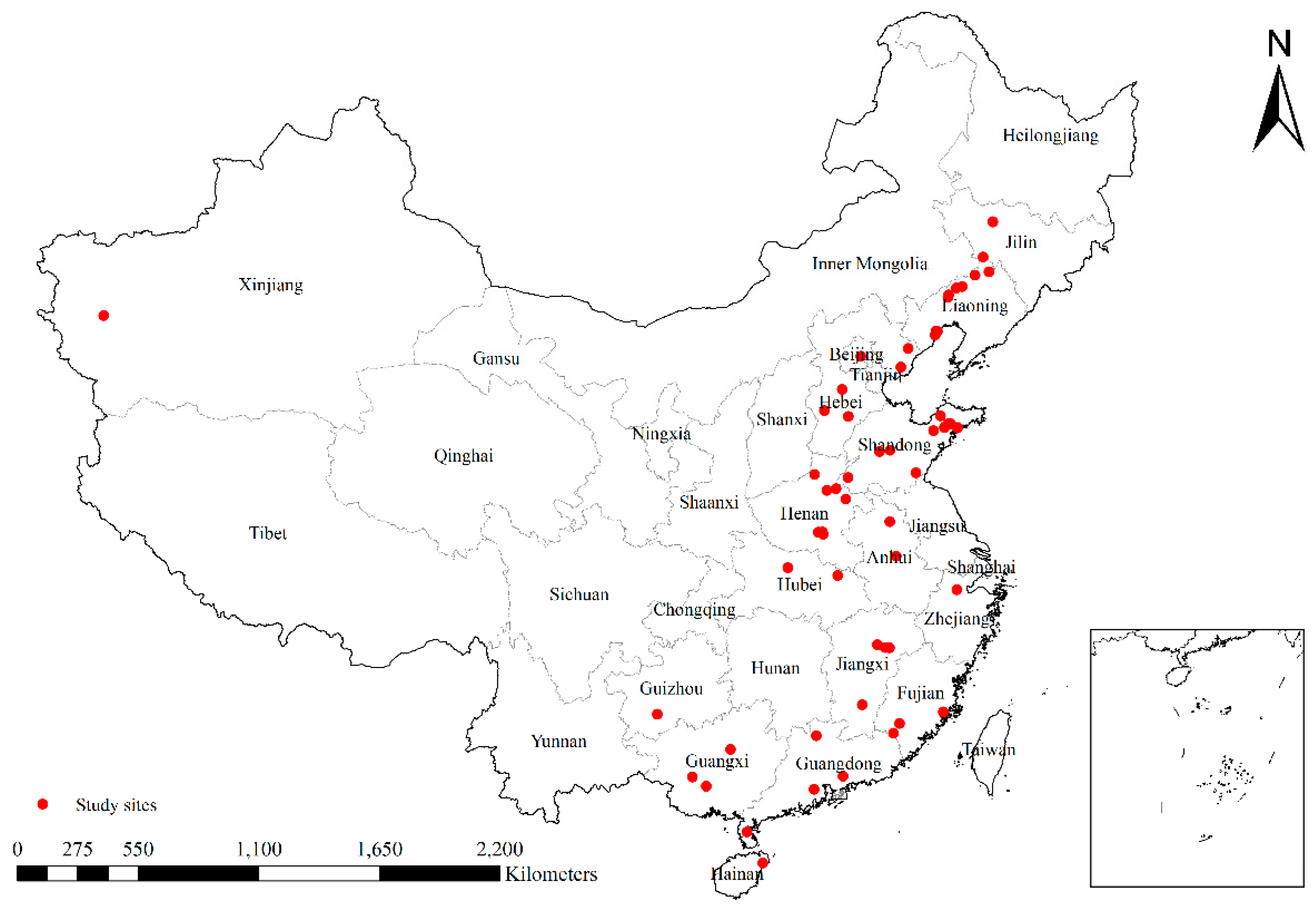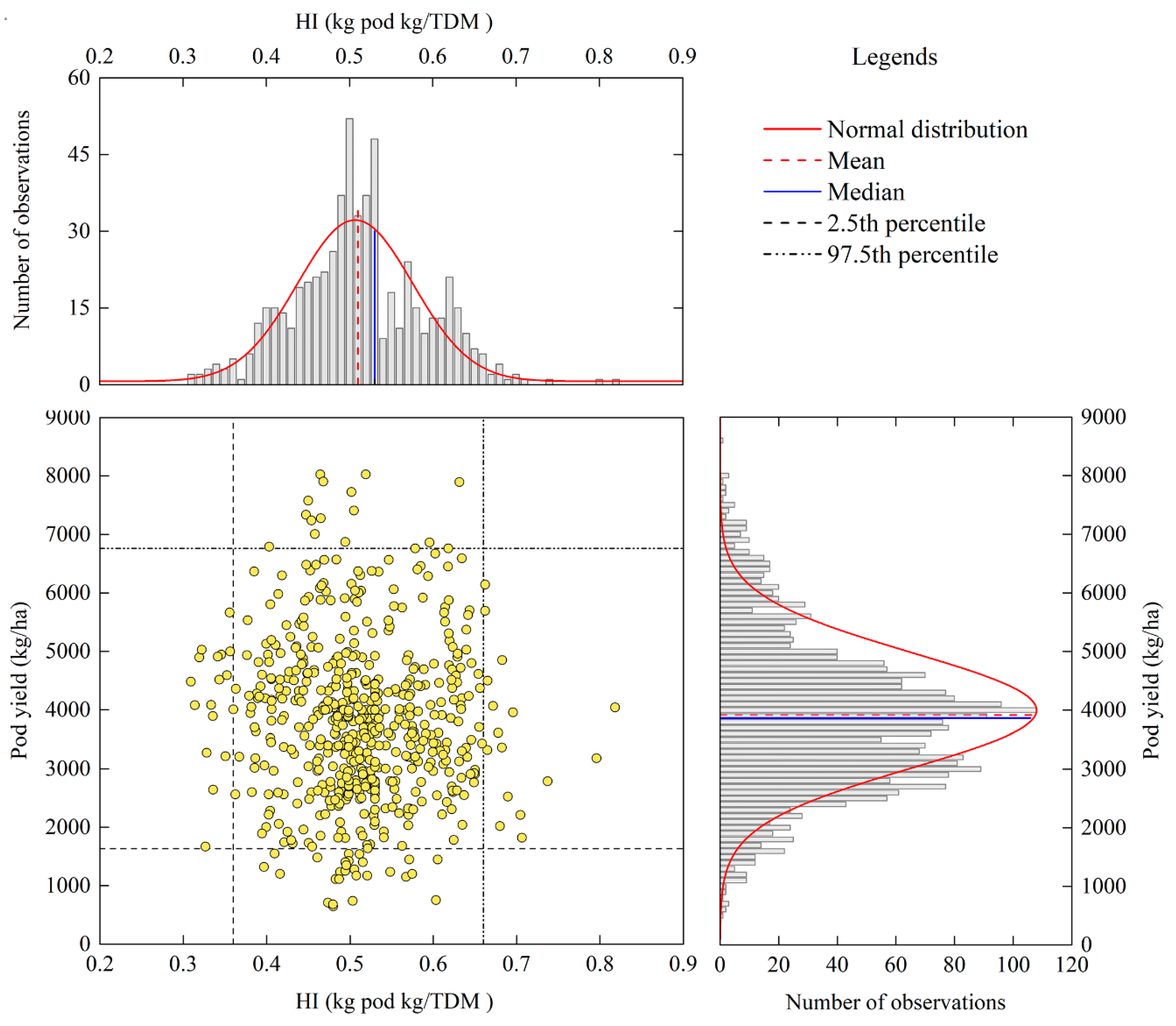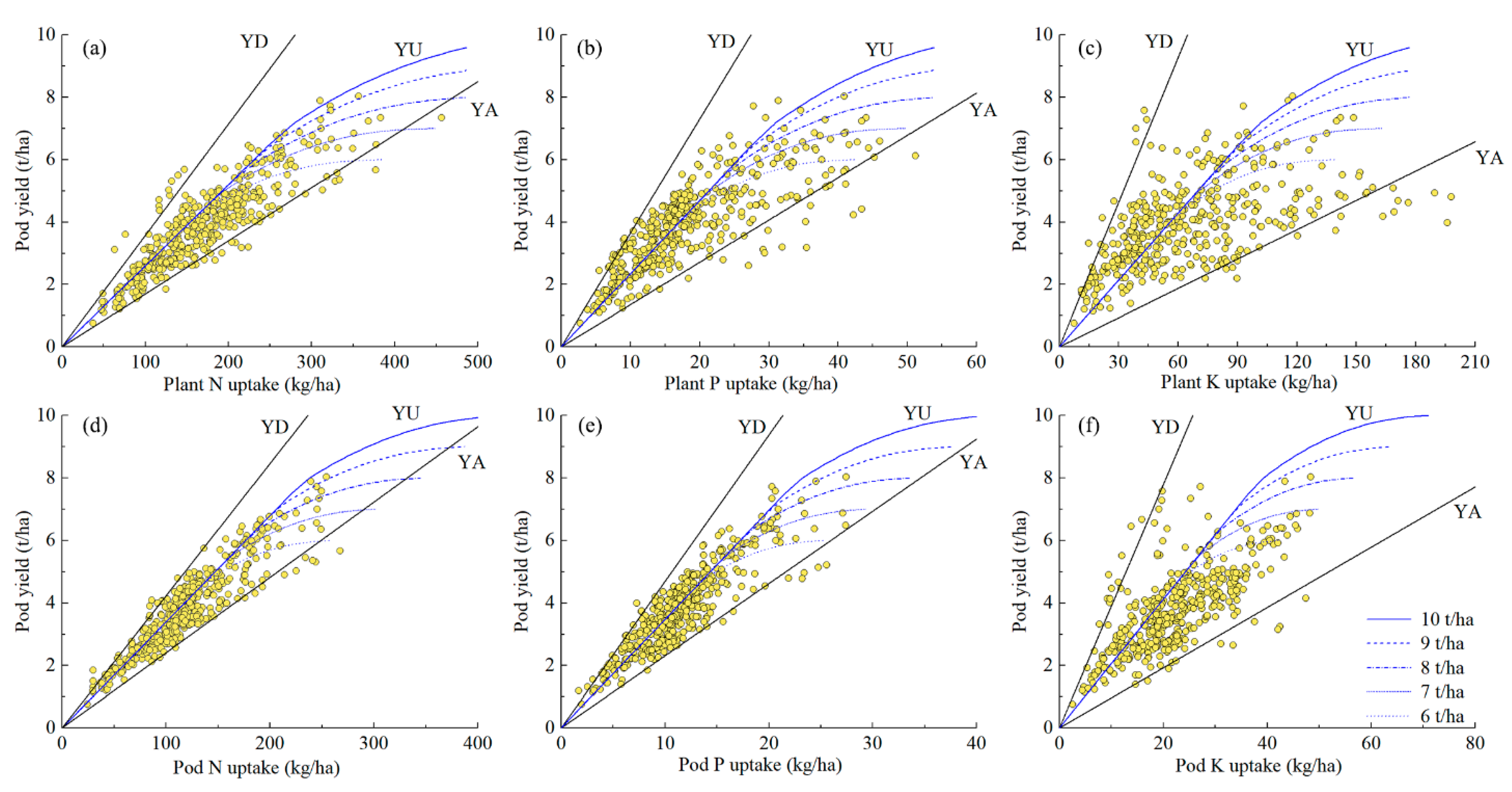Quantitative Estimation of the Nutrient Uptake Requirements of Peanut
Abstract
1. Introduction
2. Materials and Methods
2.1. Database Source and Study Sites
2.2. Model Development
2.3. Model Validation
3. Results and Discussion
3.1. Pod Yields and Nutrient Uptake Data
3.2. Internal Efficiency and Reciprocal Internal Efficiency
3.3. Estimation of the Nutrient Uptake Requirements for Specific Target Pod Yields
3.3.1. Selection of the Data for Adapting the QUEFTS Model
3.3.2. Estimation of Nutrient Uptake Requirements
3.4. Validation of the QUEFTS Model
4. Conclusions
Author Contributions
Funding
Conflicts of Interest
References
- Akram, N.A.; Shafiq, F.; Ashraf, M. Peanut (Arachis hypogaea L.): A Prospective Legume Crop to Offer Multiple Health Benefits Under Changing Climate. Compr. Rev. Food Sci. Food Saf. 2018, 17, 1325–1338. [Google Scholar] [CrossRef]
- Xie, X.-G.; Zhang, F.-M.; Wang, X.-X.; Li, X.-G.; Dai, C.-C. Phomopsis liquidambari colonization promotes continuous cropping peanut growth by improving the rhizosphere microenvironment, nutrient uptake and disease incidence. J. Sci. Food Agric. 2019, 99, 1898–1907. [Google Scholar] [CrossRef]
- FAOSTAT. Food and Agriculture Organization of the United Nations. Available online: http://www.fao.org (accessed on 1 November 2019).
- Li, Y.; Fang, F.; Wei, J.; Wu, X.; Cui, R.; Li, G.; Zheng, F.; Tan, D. Humic acid fertilizer improved soil properties and soil microbial diversity of continuous cropping peanut: A three-year experiment. Sci. Rep. 2019, 9, 12014. [Google Scholar] [CrossRef] [PubMed]
- Basu, M.; Bhadoria, P.B.S.; Mahapatra, S.C. Growth, nitrogen fixation, yield and kernel quality of peanut in response to lime, organic and inorganic fertilizer levels. Bioresour. Technol. 2008, 99, 4675–4683. [Google Scholar] [CrossRef] [PubMed]
- Fang, Z.; Zhao, X.; Li, J. The status analysis of fertilizer application on peanut in different region of Shandong province. Chin. Agric. Sci. Bull. 2009, 25, 129–133. [Google Scholar]
- Sun, J.; Huang, X.; Zhao, L.; Wang, Y.; Miao, Y. Combined application of N, P and K affecting yield and nutrient absorption of peanut in fluvo-aquic soil. Chin. Agric. Sci. Bull. 2018, 34, 23–26. [Google Scholar]
- Zhang, X. A plan for efficient use of nitrogen fertilizers. Nature 2017, 543, 322. [Google Scholar] [CrossRef]
- van Noordwijk, M.; Cadisch, G. Access and excess problems in plant nutrition. In Progress in Plant Nutrition: Plenary Lectures of the XIV International Plant Nutrition Colloquium: Food Security and Sustainability of Agro-Ecosystems through Basic and Applied Research; Horst, W.J., Bürkert, A., Claassen, N., Flessa, H., Frommer, W.B., Goldbach, H., Merbach, W., Olfs, H.W., Römheld, V., Sattelmacher, B., et al., Eds.; Springer: Dordrecht, The Netherlands, 2002; pp. 25–40. [Google Scholar] [CrossRef]
- Setiyono, T.D.; Walters, D.T.; Cassman, K.G.; Witt, C.; Dobermann, A. Estimating maize nutrient uptake requirements. Field Crop. Res. 2010, 118, 158–168. [Google Scholar] [CrossRef]
- Van Keulen, H. Nitrogen Requirements of Rice with Special Reference to JAVA; Ministry of Agriculture, Agricultural Technical Assistance Programme: Bogor, Indonesia, 1977.
- Janssen, B.H.; Guiking, F.C.T.; van der Eijk, D.; Smaling, E.M.A.; Wolf, J.; van Reuler, H. A system for quantitative evaluation of the fertility of tropical soils (QUEFTS). Geoderma 1990, 46, 299–318. [Google Scholar] [CrossRef]
- Smaling, E.M.A.; Janssen, B.H. Calibration of quefts, a model predicting nutrient uptake and yields from chemical soil fertility indices. Geoderma 1993, 59, 21–44. [Google Scholar] [CrossRef]
- Sattari, S.Z.; van Ittersum, M.K.; Bouwman, A.F.; Smit, A.L.; Janssen, B.H. Crop yield response to soil fertility and N, P, K inputs in different environments: Testing and improving the QUEFTS model. Field Crop. Res. 2014, 157, 35–46. [Google Scholar] [CrossRef]
- Xu, X.; He, P.; Pampolino, M.F.; Chuan, L.; Johnston, A.M.; Qiu, S.; Zhao, S.; Zhou, W. Nutrient requirements for maize in China based on QUEFTS analysis. Field Crop. Res. 2013, 150, 115–125. [Google Scholar] [CrossRef]
- Xu, X.; Xie, J.; Hou, Y.; He, P.; Pampolino, M.F.; Zhao, S.; Qiu, S.; Johnston, A.M.; Zhou, W. Estimating nutrient uptake requirements for rice in China. Field Crop. Res. 2015, 180, 37–45. [Google Scholar] [CrossRef]
- Witt, C.; Dobermann, A.; Abdulrachman, S.; Gines, H.C.; Guanghuo, W.; Nagarajan, R.; Satawatananont, S.; Thuc Son, T.; Sy Tan, P.; Van Tiem, L.; et al. Internal nutrient efficiencies of irrigated lowland rice in tropical and subtropical Asia. Field Crop. Res. 1999, 63, 113–138. [Google Scholar] [CrossRef]
- Liu, M.; Yu, Z.; Liu, Y.; Konijn, N.T. Fertilizer requirements for wheat and maize in China: The QUEFTS approach. Nutr. Cycl. Agroecosystems 2006, 74, 245–258. [Google Scholar] [CrossRef]
- Chuan, L.; He, P.; Jin, J.; Li, S.; Grant, C.; Xu, X.; Qiu, S.; Zhao, S.; Zhou, W. Estimating nutrient uptake requirements for wheat in China. Field Crop. Res. 2013, 146, 96–104. [Google Scholar] [CrossRef]
- Jiang, W.; Liu, X.; Wang, X.; Yin, Y. Characteristics of Yield and Harvest Index, and Evaluation of Balanced Nutrient Uptake of Soybean in Northeast China. Agronomy 2019, 9, 310. [Google Scholar] [CrossRef]
- Yang, F.; Xu, X.; Wang, W.; Ma, J.; Wei, D.; He, P.; Pampolino, M.F.; Johnston, A.M. Estimating nutrient uptake requirements for soybean using QUEFTS model in China. PLoS ONE 2017, 12, e0177509. [Google Scholar] [CrossRef]
- Kumar, P.; Byju, G.; Singh, B.P.; Minhas, J.S.; Dua, V.K. Application of QUEFTS Model for Site-Specific Nutrient Management of NPK in Sweet Potato (Ipomoea batatas L. Lam). Commun. Soil Sci. Plant Anal. 2016, 47, 1599–1611. [Google Scholar] [CrossRef]
- Zhang, J.; He, P.; Ding, W.; Xu, X.; Ullah, S.; Abbas, T.; Ai, C.; Li, M.; Cui, R.; Jin, C. Estimating nutrient uptake requirements for radish in China based on QUEFTS model. Sci. Rep. 2019, 9, 1–10. [Google Scholar] [CrossRef]
- Xu, X.; He, P.; Pampolino, M.F.; Johnston, A.M.; Qiu, S.; Zhao, S.; Chuan, L.; Zhou, W. Fertilizer recommendation for maize in China based on yield response and agronomic efficiency. Field Crop. Res. 2014, 157, 27–34. [Google Scholar] [CrossRef]
- Shen, P.; Wang, C.; Wu, Z.; Wang, C.; Zhao, H.; Shan, S.; Wu, M.; Sun, X.; Yu, T.; Zheng, Y.; et al. Peanut macronutrient absorptions characteristics in response to soil compaction stress in typical brown soils under various tillage systems. Soil Sci. Plant Nutr. 2019, 65, 148–158. [Google Scholar] [CrossRef]
- Pampolino, M.F.; Witt, C.; Pasuquin, J.M.; Johnston, A.; Fisher, M.J. Development approach and evaluation of the Nutrient Expert software for nutrient management in cereal crops. Comput. Electron. Agric. 2012, 88, 103–110. [Google Scholar] [CrossRef]
- Shehu, B.M.; Lawan, B.A.; Jibrin, J.M.; Kamara, A.Y.; Mohammed, I.B.; Rurinda, J.; Zingore, S.; Craufurd, P.; Vanlauwe, B.; Adam, A.M.; et al. Balanced nutrient requirements for maize in the Northern Nigerian Savanna: Parameterization and validation of QUEFTS model. Field Crops Res. 2019, 241, 107585. [Google Scholar] [CrossRef]
- Shen, P.; Wu, Z.; Wang, C.; Luo, S.; Zheng, Y.; Yu, T.; Sun, X.; Sun, X.; Wang, C.; He, X. Contributions of rational soil tillage to compaction stress in main peanut producing areas of China. Sci. Rep. 2016, 6, 38629. [Google Scholar] [CrossRef]
- Chen, M.; Li, X.; Yang, Q.; Chi, X.; Pan, L.; Chen, N.; Yang, Z.; Wang, T.; Wang, M.; Yu, S. Dynamic Succession of Soil Bacterial Community during Continuous Cropping of Peanut (Arachis hypogaea L.). PLoS ONE 2014, 9, e101355. [Google Scholar] [CrossRef]
- Fang, Z.G.; Zhao, X.F. Nutrient absorption and distribution characteristics of different peanut varieties in Jiaodong peninsula. J. Plant Nutr. Fertil. 2015, 21, 241–250. [Google Scholar]
- Dobermann, A.; Cassman, K.G. Plant nutrient management for enhanced productivity in intensive grain production systems of the United States and Asia. Plant Soil 2002, 247, 153–175. [Google Scholar] [CrossRef]





| Parameter | Unit | N 1 | SD | Mean | Min. | 25% Q 2 | Med. | 75% Q | Max. |
|---|---|---|---|---|---|---|---|---|---|
| Pod yield | kg/ha | 2513 | 1278 | 3918 | 500 | 3018 | 3864 | 4650 | 8602 |
| Haulm | kg/ha | 593 | 1557 | 3328 | 687 | 2202 | 2979 | 4208 | 8879 |
| Harvest Index | kg/kg | 593 | 0.08 | 0.51 | 0.31 | 0.46 | 0.51 | 0.56 | 0.82 |
| [N] in pod | g/kg | 590 | 6.1 | 35.6 | 13.9 | 31.5 | 34.9 | 39.6 | 64.5 |
| [P] in pod | g/kg | 530 | 0.98 | 3.6 | 1.6 | 3.0 | 3.4 | 4.0 | 8.2 |
| [K] in pod | g/kg | 515 | 2.4 | 7.1 | 2.2 | 5.5 | 6.8 | 8.2 | 17.3 |
| [N] in haulm | g/kg | 502 | 3.7 | 14.2 | 6.9 | 11.8 | 14.0 | 16.2 | 38.4 |
| [P] in haulm | g/kg | 486 | 0.69 | 1.7 | 0.31 | 1.2 | 1.5 | 2.2 | 4.0 |
| [K] in haulm | g/kg | 472 | 6.8 | 12.9 | 2.1 | 7.7 | 11.5 | 17.0 | 35.8 |
| N uptake pod | kg/ha | 481 | 45.2 | 120.3 | 24.5 | 91.2 | 115.5 | 144.5 | 267.6 |
| P uptake pod | kg/ha | 458 | 4.5 | 11.6 | 1.7 | 9.0 | 11.0 | 13.7 | 27.4 |
| K uptake pod | kg/ha | 466 | 9.0 | 22.6 | 2.6 | 17.1 | 21.7 | 28.2 | 48.4 |
| N uptake haulm | kg/ha | 421 | 27.7 | 49.1 | 7.7 | 29.1 | 42.1 | 65.4 | 209.1 |
| P uptake haulm | kg/ha | 407 | 3.7 | 5.7 | 0.75 | 3.0 | 4.6 | 7.3 | 24.5 |
| K uptake haulm | kg/ha | 401 | 29.8 | 42.0 | 3.6 | 21.2 | 35.5 | 55.7 | 193.9 |
| N uptake total | kg/ha | 586 | 64.6 | 163.6 | 30.1 | 117.9 | 155.1 | 203.5 | 456.7 |
| P uptake total | kg/ha | 530 | 8.8 | 17.8 | 2.8 | 11.5 | 15.9 | 21.8 | 51.2 |
| K uptake total | kg/ha | 515 | 36.6 | 59.2 | 7.6 | 31.4 | 50.5 | 79.8 | 228.1 |
| N-HI 3 | kg/kg | 421 | 0.09 | 0.72 | 0.24 | 0.66 | 0.73 | 0.77 | 0.90 |
| P-HI | kg/kg | 407 | 0.10 | 0.69 | 0.42 | 0.62 | 0.69 | 0.76 | 0.93 |
| K-HI | kg/kg | 401 | 0.13 | 0.39 | 0.13 | 0.29 | 0.37 | 0.48 | 0.76 |
| Parameter | Unit | N 1 | SD | Mean | Min. | 25% Q 2 | Med. | 75% Q | Max. |
|---|---|---|---|---|---|---|---|---|---|
| IE-N | kg/kg | 586 | 5.2 | 24.7 | 14.3 | 21.0 | 24.2 | 27.2 | 49.8 |
| IE-P | kg/kg | 530 | 66.8 | 238.5 | 89.8 | 199.1 | 230.9 | 271.9 | 483.1 |
| IE-K | kg/kg | 515 | 45.1 | 85.1 | 17.9 | 52.2 | 72.9 | 104.8 | 231.5 |
| RIE-N | kg/t | 586 | 8.3 | 42.2 | 20.1 | 36.8 | 41.4 | 47.6 | 69.9 |
| RIE-P | kg/t | 530 | 1.4 | 4.5 | 2.1 | 3.7 | 4.3 | 5.0 | 11.1 |
| RIE-K | kg/t | 515 | 7.9 | 15.3 | 4.3 | 9.5 | 13.7 | 19.2 | 55.9 |
| Nutrients | Set I | Set II | Set III | |||
|---|---|---|---|---|---|---|
| a (2.5th) | d (97.5th) | a (5th) | d (95th) | a (7.5th) | d (92.5th) | |
| N | 17.0 | 35.7 | 17.9 | 30.3 | 18.6 | 29.5 |
| P | 135.6 | 364.9 | 144.0 | 339.3 | 149.8 | 314.9 |
| K | 31.3 | 154.4 | 32.4 | 137.4 | 34.2 | 123.2 |
| Pod Yields (kg/ha) | Plant IEs (kg/kg) 1 | Plant RIEs (kg/t) 2 | Pod RIEs (kg/t) 3 | Ratios in Pod (%) 4 | ||||||||
|---|---|---|---|---|---|---|---|---|---|---|---|---|
| N | P | K | N | P | K | N | P | K | N | P | K | |
| 0 | 0.00 | 0.00 | 0.00 | 0.00 | 0.00 | 0.00 | 0.00 | 0.00 | 0.00 | 0.00 | 0.00 | 0.00 |
| 1000 | 26.0 | 235.0 | 71.6 | 38.4 | 4.3 | 14.0 | 29.4 | 2.9 | 4.9 | 76.5 | 67.4 | 34.7 |
| 2000 | 26.0 | 235.0 | 71.6 | 38.4 | 4.3 | 14.0 | 29.4 | 2.9 | 4.9 | 76.5 | 67.4 | 34.7 |
| 3000 | 26.0 | 235.0 | 71.6 | 38.4 | 4.3 | 14.0 | 29.4 | 2.9 | 4.9 | 76.5 | 67.4 | 34.7 |
| 4000 | 26.0 | 235.0 | 71.6 | 38.4 | 4.3 | 14.0 | 29.4 | 2.9 | 4.9 | 76.5 | 67.4 | 34.7 |
| 5000 | 26.0 | 235.0 | 71.6 | 38.4 | 4.3 | 14.0 | 29.4 | 2.9 | 4.9 | 76.5 | 67.4 | 34.7 |
| 6000 | 26.0 | 235.0 | 71.6 | 38.4 | 4.3 | 14.0 | 29.4 | 2.9 | 4.9 | 76.5 | 67.4 | 34.7 |
| 7000 | 25.8 | 232.8 | 70.9 | 38.8 | 4.3 | 14.1 | 29.4 | 2.9 | 4.9 | 75.8 | 66.8 | 34.4 |
| 8000 | 24.3 | 219.0 | 66.7 | 41.2 | 4.6 | 15.0 | 29.8 | 2.9 | 4.9 | 72.2 | 63.6 | 32.7 |
| 9000 | 21.9 | 197.6 | 60.2 | 45.7 | 5.1 | 16.6 | 32.6 | 3.2 | 5.4 | 71.4 | 62.9 | 32.4 |
| 10,000 | 20.6 | 185.7 | 56.6 | 48.6 | 5.4 | 17.7 | 43.1 | 4.2 | 7.1 | 88.6 | 78.0 | 40.2 |
© 2020 by the authors. Licensee MDPI, Basel, Switzerland. This article is an open access article distributed under the terms and conditions of the Creative Commons Attribution (CC BY) license (http://creativecommons.org/licenses/by/4.0/).
Share and Cite
Xie, M.; Wang, Z.; Xu, X.; Zheng, X.; Liu, H.; Shi, P. Quantitative Estimation of the Nutrient Uptake Requirements of Peanut. Agronomy 2020, 10, 119. https://doi.org/10.3390/agronomy10010119
Xie M, Wang Z, Xu X, Zheng X, Liu H, Shi P. Quantitative Estimation of the Nutrient Uptake Requirements of Peanut. Agronomy. 2020; 10(1):119. https://doi.org/10.3390/agronomy10010119
Chicago/Turabian StyleXie, Mengmeng, Zhongqiang Wang, Xinpeng Xu, Xing Zheng, Hanyu Liu, and Puxiang Shi. 2020. "Quantitative Estimation of the Nutrient Uptake Requirements of Peanut" Agronomy 10, no. 1: 119. https://doi.org/10.3390/agronomy10010119
APA StyleXie, M., Wang, Z., Xu, X., Zheng, X., Liu, H., & Shi, P. (2020). Quantitative Estimation of the Nutrient Uptake Requirements of Peanut. Agronomy, 10(1), 119. https://doi.org/10.3390/agronomy10010119






